Planning a Visit
Logistics
- Space
The planetarium requires a large indoor space at least 25′ x 25′ (i.e. gym, cafeteria, activity room) that has a 14′ ceiling. We also need access to a standard 120v electrical outlet to power the equipment. - Tables
Host will need to have 8-10 tables available for us to display the exhibits on. - Chairs
We ask the host to provide 3-4 chairs that we can place in the planetarium for teachers to sit on. - Setup Time
SkyDome presentors will need to arrive about an hour prior to the program to setup the equipment. Take down usually takes about 30 minute. - Lunch / Dinner (Where Applicable)
When developing the schedule please allow 45mins. to an hour for SkyDome presentors to leave the school to get lunch. If the school would like to provide lunch for the presentors, so they don’t have to leave, lunch can be as short as 30 mins. - Schedule
Please have a printout of the day’s schedule available for SkyDome host .
Ceiling Height - Is your space high enough?
- Planetarium Dome – 14′ Clearance
The planetarium dome uses a special fabric to create the projection surface. While it is generally durable, it can be damaged. During usage it deflates / inflates and moves around as students are loading into the dome. This means there CANNOT be any overhead obstructions that it could potentially rub against and damage the dome.
EXAMPLE – In this example, the ceiling height is 14′, but there are I-Beams, light fixtures and HVAC ducts running under it. As you can see from the image on the right, when we inflated the dome, the I-Beams, light fixtures and ducts are all visible from inside the dome. If there had been any kind of spur or screw on the beam or ducts, it could have easily ripped the dome or been burned by the light fixture. A replacement dome is over $10k, so we can not risk setting up in these circumstances.
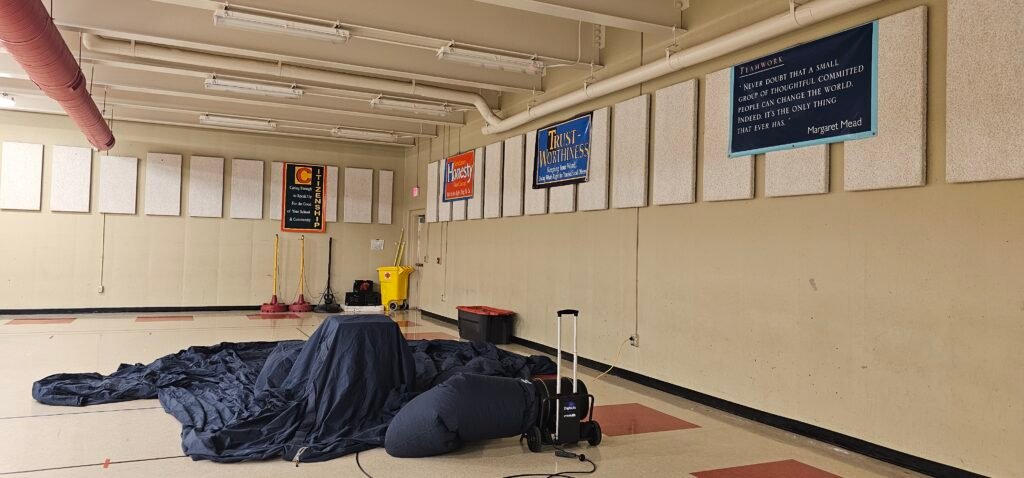
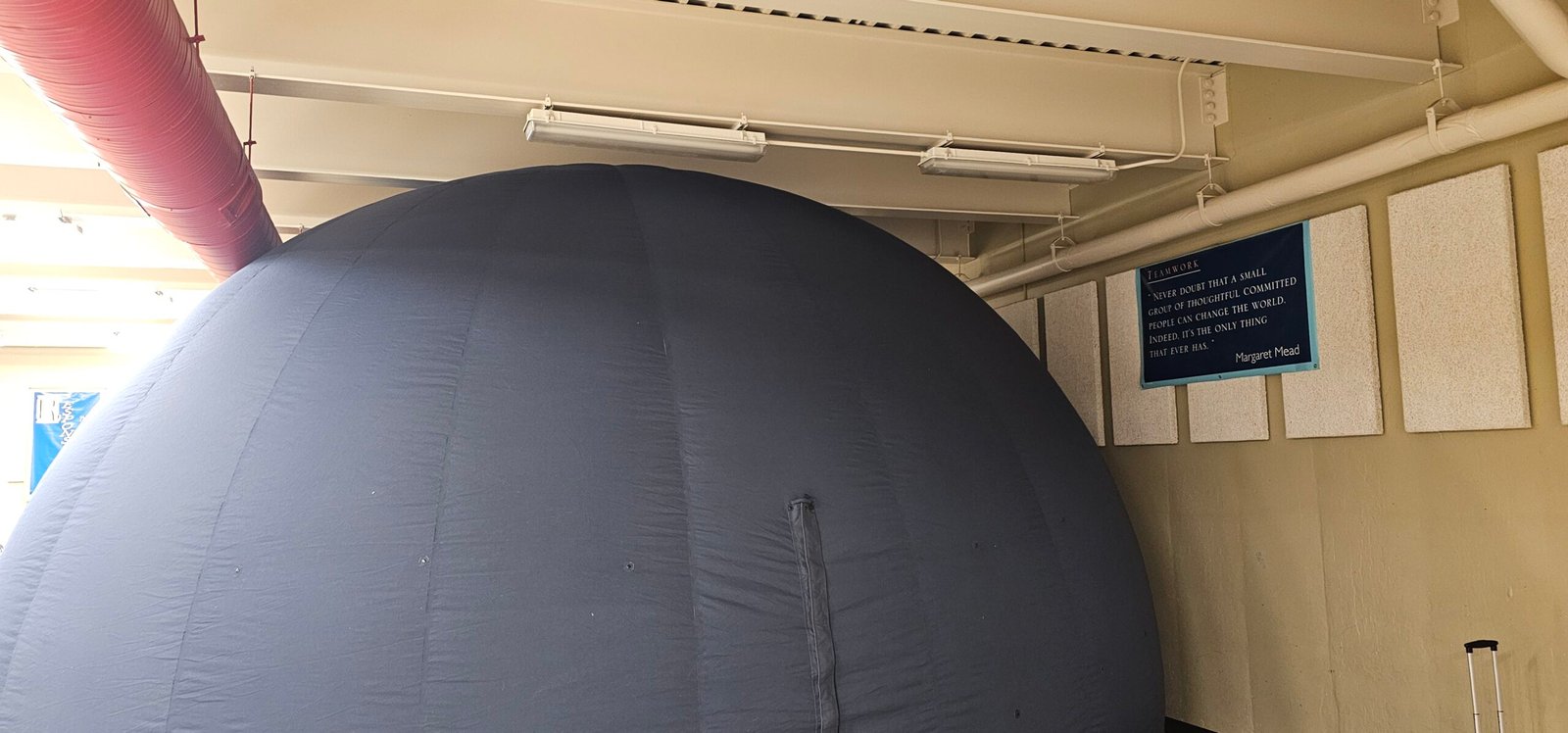
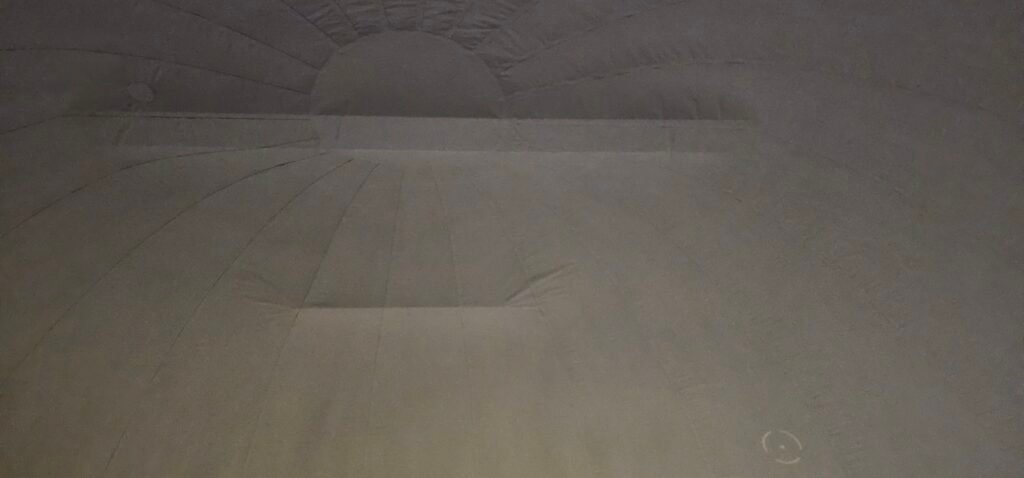
Program Blocks
A program block is the amount of time we spend with a class or group of students and generally consists of the following:
- Introduction
An overview of the exhibits, planetarium, telescopes (if any) and any science demonstrations. - Planetarium Program
Live night sky tours and full dome shows. - Exhibits
Students are free to browse the exhibits under supervision of their teacher and SkyDome staff. - Telescope (if applicable)
Students go outside in small groups to look at objects in the sky.
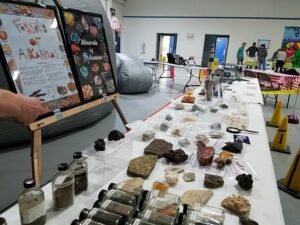
Setting Block Lengths (45mins. - 2 hours)
The length of each block is determined by the school and can last from 30 minutes to 2 hours.
- Recommended block lengths:
> Kindergarten – 2nd Grade: 30 – 45 minutes
> 3rd & higher: 1-2 hours (minimum 45 minutes) - Allowing Enough Time
Most schools want as many students as possible to experience the planetarium, which we understand. Please bear in mind however that by rushing students through the program, it can take away from and shorten the quality of the experience for any one student. We recommend focusing on 1 or 2 grades and giving them the maximum amount of time possible. Consider making it an experience for a select grade(s), giving upcoming students something to look forward to when they reach that target grade. For example, each year 3rd graders get to go through. That said, we’re happy to be flexible to meet your situation. - Telescope Time
Daytime telescope viewing is provided by request. To allow enough time for the planetarium and exhibits, plus the telescope viewing, block lengths must be at least 1 hour or more.
Setting the Start Time
Whether lodging will be required the night prior to our visit will depend on the start time for your first block and the travel time to your location. If the start time for your first block is later than 7:30am + travel time from Greenbrier an overnight stay will generally not be needed.
- 7:30am is based on a 6:30am departure from Greenbrier + 1 hour setup time when we arrive
- For example:
- A school in Little Rock is a 60 minute drive. 7:30am + 60 minute drive means a start time for the first block as early as 8:30am
- A school in Texarkana is a 2h 30m drive. 7:30am + 2:30 means a start time for the first block at 10am. An earlier start time would require an overnight stay and lodging fee.
Preparing Students
- Teacher Participation
Where possible, we encourage the students’ teachers to experience the planetarium with them. We have found that students get more from the program, have fewer discipline issues, and the teachers are better prepared to reinforce what was taught. Plus, teachers usually love the experience just as much…. - Bathroom Breaks
Once inside the planetarium, participants need to stay inside for the duration of the program, if at all possible. Anyone needing to leave the dome breaks the light seal, and the program generally has to be put on hold as students look to see what is happening. This also places additional wear on the dome’s entrance, which over time can lead to costly repairs or the need to replace the dome. In preparation for the visit to the planetarium, please have the teachers allow the students a bathroom break. - Food & Drinks
No food or drinks are allowed in the planetarium. In the past, we have found sucker sticks and had to peel gum off the dome. Since students are seated on the floor, the next class may unknowingly sit on anything that was accidentally spilled or left behind.
Students per Block
- Maximum Students per Block: 50
The planetarium can accommodate up to 50 students, thus we recommend a maximum of two classrooms per block. - Spaced Out
While we try to offer flexability to meet your situation (i.e. we could accommodate 51 or 52 students), please keep in mind the planetarium has a limited amount of space. By adding more students than the maximum recommendation, seating becomes tighter and less comfortable in the dome which can take away from the learning experience and increase discipline issues.
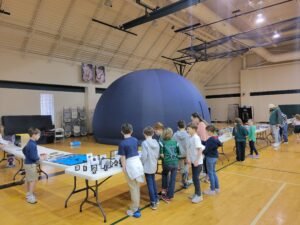
Volunteer Docents
- Students
Do you have a group of older students (5 or fewer at a time) – perhaps GT or students with a science interest, or high school students looking for community hours – that can serve as docents? We can assign student docents to help explain one of our many exhibits to their classmates as they visit the exhibits. This is an opportunity for docents to learn more about the displays and gain a valuable experience as they teach their fellow classmates. The following stations are available if you’d like docents to research them prior to our visit:- Spaceflight History – Apollo / Mercury Programs
- Energy – Tesla Coils / Electricity
- Geology – Meteorites / Petrified Wood
- Aviation – Airplanes / Science of Flight
- Astronomy – Scale of Solar System / Milky Way Galaxy
- Parents
Parent volunteers, while not necessary, are also welcome to help with the exhibits and student traffic.
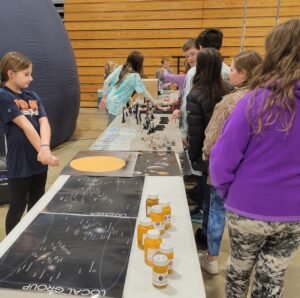
Selecting Planetarium Programming
- Live Sky Tours – These are the primary focus of our visit, as we want to share and encourage the students to explore the current night sky. Depending on grade and other programming, these last from 10-20 minutes.
- Full Dome Movies – In addition to the live sky tour, we offer a selection of professionally produced full dome planetarium shows. These are the same types of shows offered in the largest planetarium in the world and are a great addition to our visit. Our current lineup:
- K-2: “Max Goes the the Moon” – This program is based on the first children’s science book read from space. Students join Max the dog on his trip to the moon; learning about the phases, what it is like on the moon and the history of humans going to the moon.
- 3-4: “Two Small Pieces of Glass” – Students join two teenagers as they learn about the history of the telescope and how it has unlocked the universe.
- 5 & up: “Foward to the Moon” – Learn about NASA’s efforts to return humans to the moon; including astronaut interviews, future moon bases, and how students can get involved.
Telescopes
– Let students see real astronomical objects in the daytime sky! Drives home the fact they are still there even during the daytime.
- GPS TELESCOPE – This is a 9.25″ telescope that uses GPS satellites so it can find objects in the daytime sky. The moon, Venus, Jupiter and several of the brightest stars are visible weather permitting. If you’re holding an evening event, this telescope (depending on light pollution) can show students the moon, planets, and deep space wonders.
- SOLAR TELESCOPE – This is a telescope specifically designed to allow students to safely look directly at the surface of the sun. We only make this option available to students 5th grade or older. Students need to be old enough to understand the dangers of looking at the sun prior to using this telescope.
- LOGISTICS – Telescope(s) need to be setup in a semi-secure area just outside where the planetarium is setup. We generally take small groups of 3-5 students at a time (while the others explore the exhibits) outside for a look through the telescope after the planetarium presentations. It usually takes 10-15 minutes to cycle through all of the students. Between blocks and during the planetarium programs the telescope is left alone outside, so it needs to be setup in an area where it won’t be bothered between programs.
Student Supervison and Discipline
- At no time can we take responsibility for students. A teacher or organization official must be present at ALL TIMES.
- At least one teacher or responsible organization official must accompany students into the SkyDome Planetarium to supervise students and handle any discipline issues. We can not start a program in the dome unless a representative is present.
- The SkyDome projection equipment, dome, and exhibits are very expensive and some items are irreplacable. In order to make sure they can be enjoyed by as many students as possible into the future, we reserve the right to end all programming and dismiss a student or group of students if they exhibit any conduct that is or could be harmful to the equipment, exhibits or other attendees.